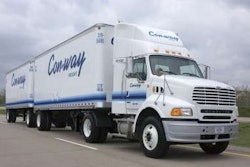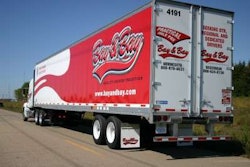Continuing on its path to meet the next round of emissions standards required for 2010, Navistar on Wednesday, March 4, unveiled its 2010 MaxxForce DT Advanced EGR (exhaust gas recirculation) midrange diesel engine at the National Truck Equipment Association (NTEA) Work Truck Show in Chicago.
“Our strategy of 2010 emissions compliance through the use of an EGR-only solution is on track,” said Steve Guillaume, Navistar general manager of vocational trucks. “With our lineup of MaxxForce Advanced EGR engines, we’re delivering a simple and straightforward solution that places the burden of emissions compliance on the manufacturer, not the customer.”
At the Work Truck Show, Navistar also:
Midrange Advanced EGR engine
To meet the U.S. Environmental Protection Agency 2010 emissions requirements for on-highway diesel engines, MaxxForce Advanced EGR engines will use advanced fuel injection, air management, electronic controls and proprietary combustion technology.
“We’ve been conducting rigorous testing and analysis in our engine labs and currently have 2010 prototype engines installed in medium- and heavy-duty test trucks,” said Ramin Younessi, group vice president of truck and engine product development. “These test vehicles are on the road in real-world conditions and will log millions of miles of real-world experience before the launch of these engines.”
Other major truck and engine manufacturers are choosing a 2010 emissions path through selective catalytic reduction (SCR), which requires the use of an additional operating fluid, called urea, as well as additional aftertreatment equipment. Navistar says that for SCR systems in the United States, EPA will mandate a series of driver compliance requirements, as well as a disabling system that can power down the engine automatically when urea levels run low.
“We strongly believe the accountability for emissions compliance should rest on the manufacturer, not on the actions of the driver, the reliability of very complex technologies or the impact of climatic conditions,” Guillaume said. “The development and testing of our EGR solution for 2010 is in advanced stages, and we are confident that our engines will deliver the performance, reliability and low operating costs our customers demand.”
Four-wheel-drive hybrid truck
The WorkStar Hybrid 4×4, part of International’s severe-service lineup of trucks for heavier duty applications, adds to Navistar’s lineup of diesel-electric hybrid vehicles. Navistar also produces the medium-duty International DuraStar Hybrid as well as IC Bus brand diesel-electric hybrid passenger buses for both school bus and commercial bus applications.
“With the new International WorkStar Hybrid 4-by-4 in our lineup, we continue to lead the way in providing energy-saving environmentally-friendly solutions for our customers,” Guillaume said. “By developing another hybrid truck that reduces fuel consumption and greenhouse gas emissions, we’re able to deliver significant savings to the customers’ bottom line and, at the same time, help them reduce their overall carbon footprint.”
Navistar says the WorkStar Hybrid 4×4 can provide dramatic fuel savings of nearly 60 percent in utility-type applications when the engine often can be shut off, but electric power still operates the vehicle; beyond the fuel savings potential, the WorkStar Hybrid 4×4 produces zero emissions when auxiliary equipment, like an overhead utility bucket, operates solely on the truck’s hybrid battery power. The four-wheel drive capability of the truck is suited for customers such as utility companies that need a truck to operate in off-highway conditions but also are looking to save energy and project a green image.
The Hybrid Truck Users Forum, a national group of utility companies that own hybrid trucks, estimates that 1,000 to 1,500 gallons of fuel can be saved per utility truck annually. At the high diesel prices seen throughout most of 2008, that equates to a savings of $4,000-$6,000 in fuel per truck annually, according to Navistar; it also results in annual greenhouse gas reductions of 11 to 16.5 tons of carbon dioxide per unit.
Navistar says the International lineup of hybrid commercial trucks uses a mild parallel-type diesel-electric hybrid architecture developed by Eaton Corp., which leads to less diesel fuel use and fewer emissions; the hybrid-electric system utilizes a regenerative braking system to recover energy normally lost during braking, stores the energy in batteries and adds power back into the driveline during starts and acceleration. This capability makes the truck more efficient in standard driving, particularly in city and stop-and-go driving, according to Navistar; when the truck reaches a worksite, the hybrid system can power booms, aerial devices and other tools needed at the location for up to 90 minutes without the engine running, significantly reducing noise, emissions and fuel costs.
RouteMax refrigerated hybrid truck
Representatives from Navistar presented the keys to an International DuraStar Hybrid with a RouteMax refrigerated body to Kraft Foods during the Work Truck Show.
“Kraft Foods is excited to be the first company to roll out this unique diesel-electric hybrid truck that uses new technology to transport frozen foods like our DiGiorno pizza,” said Mike Cole, Kraft Foods director of transportation for North America. “This truck is one more step forward in our transportation sustainability initiatives. As part of our commitment to reduce carbon dioxide emissions, we are applying new technologies like this one, cutting down on the distances our fleet travels and partnering with governmental agencies.”
Navistar says this DuraStar Hybrid truck with a RouteMax refrigerated body is a pilot unit and is the first of its kind on the road; the energy-saving system in this delivery truck is expected to offer Kraft Foods as much as a 30 percent fuel saving versus a traditional diesel-powered truck.
In addition to the hybrid system, this truck also features RouteMax, a self-powered extended-route cold plate refrigeration system offered exclusively through Navistar in cooperation with Johnson Truck Bodies. Onboard power from the hybrid system provides power for the refrigeration solution to accelerate body temperature recovery during the truck’s daily operation, nearly doubling the length of time its cold plates provide cooling for cargo and protecting assets, according to Navistar; RouteMax is an efficient alternative to a traditional diesel-powered refrigerated blower unit, saving as much as 1,400 gallons of fuel per year.
Chicago gets first hybrid truck
As part of this week’s Green Truck Summit, held in conjunction with the Work Truck Show, representatives from Navistar officially presented the keys to a 33,000-pound medium-duty International DuraStar Hybrid to Howard Henneman, the City of Chicago’s Commissioner of Fleet Management.
“We’re excited to partner with the City of Chicago in its ongoing efforts to become the most environmentally-friendly city in the world,” Guillaume said. “Chicago recognizes the importance of a green truck fleet, and the International DuraStar Hybrid will play a critical role in saving fuel and reducing emissions.”
“We are pleased to be the first municipality in the region to utilize this new technology,” said Howard Henneman, the City of Chicago’s commissioner of fleet management. “We expect that this technology will be an important part of our environmental efforts moving forward.”
Navistar shares a common history with Chicago, tracing its roots back to the former McCormick and International Harvester. “We’ve worked closely with the City of Chicago going as far back as the 1830s, and we’re proud to continue that relationship today and into the future as Navistar proudly sponsors the City of Chicago’s bid for the 2016 Olympic Games,” Guillaume said. “With a comprehensive lineup of energy-efficient and environmentally-friendly trucks and buses, we’re excited about helping Chicago host the greenest Summer Olympics ever if it’s awarded the 2016 games.”










